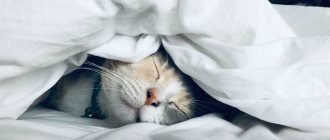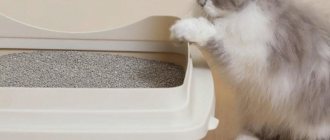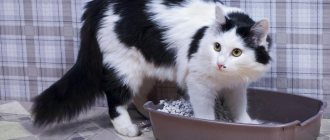Analysis of reasons with a tray and a cat
Experts conventionally identify two etiological factors for litter box refusal: behavioral and medical. The first category includes various psychological problems and emotional stress. The medical factor includes the presence of any disease in the pet.
Behavioral approach
From a psychological point of view, the most common reason for refusing a litter box is a dislike of the litter. In this case, changing the product to another eliminates the problem, and the pet stops pooping in the wrong place. In addition, an animal may choose a certain place, even if there is no cat litter box there.
Refusal to use the toilet can occur if it is heavily soiled and has a pronounced unpleasant odor.
A pet may refuse to use the tray if there is a stranger in the house. At the same time, the cat experiences significant stress and chooses secluded places for the toilet.
A common factor in changing a pet's behavior is the arrival of a new animal in the house. In this case, the refusal to go to the toilet in a certain place is explained by the development of stress and conflict with the new pet.
Emotional stress affects the psychological state of a cat. If the owner constantly swears at the pet in a raised voice or uses physical force as punishment, the animal may not only ignore the tray, but also refuse food.
A problem with the toilet may arise when moving to a new living space, since the usual odors are absent, and the process itself has a stressful effect on the pet.
Medical point of view
There are a large number of somatic pathologies and physiological processes that lead to the fact that the pet ceases to relieve itself in a specially designated place.
Going to the toilet in the wrong place sometimes accompanies a period of estrus, during which the hormonal levels in the pet’s body change. In this case, sterilizing the animal can eliminate this problem.
Diseases of internal organs are often accompanied by urinary incontinence, dysuric disorders and other pathologies. Most often, the reason for refusing the tray is inflammatory diseases of the genitourinary system - urolithiasis, urethritis, cystitis. Due to the resulting inflammation of the mucous membrane, the animal cannot restrain the urge to urinate, as a result of which bowel movements occur in the wrong place. The symptom is also observed in intestinal diseases, hepatitis, endocrine diseases, allergic reactions and other pathologies.
Involuntary bowel movements may signal the onset of intestinal disease due to inflammation or disruption of its structure. These pathologies include colitis, megacolon, intestinal infections, poisoning and other diseases.
In old age, the sphincter muscles may weaken, causing the cat to stop using the litter box due to incontinence.
Wrong filler
Cats are self-sufficient and fastidious animals. Often the reason that a pet categorically refuses to go to the litter tray is that the owner does not like the litter chosen by the owner. At the same time, even in the filler he doesn’t like, he will still write.
This is explained by the fact that the animal spends much less time on the process of urination than on defecation. Therefore, if the cat is uncomfortable with its paws immersed in the litter for some time, it will walk past the tray. It is easy to solve this problem - just change the type of cat litter.
Furnishings and smell, toilet filler
In order for a cat to go to the toilet in a certain place, it is important to choose the right location and filler. If the pet does not like the location of the tray and the means that absorbs feces, the animal may shit in the wrong place.
Experts recommend placing the tray in a secluded place, where people are present as little as possible and there are no sources of loud sounds. In addition, it is important that the cat is comfortable sitting in the tray, so its location should be in an easily accessible place.
The contents of the toilet should not be dirty or smell bad, so you should wash the container and change the filler on time. But when training your pet to go to the toilet in a certain place, you should take into account that the animal is guided by the smell, so if the cat shits in the wrong place, use a napkin to blot the feces and put it in the tray. When cleaning the toilet, you should not use household chemicals that have a strong odor, as this may scare away your pet.
Main reasons
- Urolithiasis is characterized by the formation of stones in the urethra and kidneys. The etiological factor in the occurrence of the disease is poor nutrition, a sedentary lifestyle, excess weight, prolonged abstinence from urination due to a dirty tray, and diseases of the genitourinary system. The clinical picture is represented by painful urination, while the cat produces a small amount of urine, and incontinence is characteristic as a result of reflexive relaxation of the sphincter when pain occurs. In addition, stones can injure the mucous membrane, resulting in the presence of blood in the urine. Most often, cats under 7 years of age are susceptible to the disease.
- Urethritis is inflammation of the urethra. The disease develops against the background of a long course of urolithiasis, sterilization, infection with pathogens, and trauma. It is painful for a cat to urinate; the animal empties its bladder in the wrong place, since the urge to urinate is accompanied by severe pain.
- Cystitis is inflammation of the mucous membrane of the bladder. As a rule, the etiological factor is bacterial infection. The cat's urination becomes more frequent, pain is observed, and a small amount of urine is released, down to drops.
- Colitis is a fairly common intestinal disease, with the formation of an inflammatory process in the large intestine. The cause of the disease can be improper feeding of the pet, activation of opportunistic intestinal microflora against the background of a weakened immune status or undergoing a course of antibiotic therapy, helminthiases, allergies, intestinal infections, injuries. The clinical manifestation is increased frequency of bowel movements, abnormal stool, and the pet may go to the toilet in the wrong place.
- Intestinal infections - damage to the intestines by specific pathogens. The animal suffers from nausea, vomiting, and diarrhea. There may be a rise in temperature.
- Megacolon is an anomaly in which the large intestine increases in size as a result of impaired smooth muscle tone. The causes of the disease have not been fully studied. Experts believe that the etiological factor may be genetic predisposition, intestinal trauma as a result of ingestion of solid foreign bodies, trauma to the pelvis, impaired muscle tone as a result of frequent constipation and deliberately restraining the urge to defecate due to a dirty tray.
- With age, various dystrophic changes occur in all organs and tissues. Thus, the muscles of the sphincters of the genitourinary system and gastrointestinal tract are weakened, which leads to the fact that an old cat can shit in the wrong place.
- Contamination of the litter box is a common reason why a pet may defecate anywhere in the living space. Cats are clean animals that love clean conditions, so a large amount of excrement in the toilet, as well as the strong unpleasant odor emanating, can cause disgust in the pet. It is necessary to wash the tray regularly. In addition, poor litter box maintenance can result in your pet resisting the urge to defecate. This can lead to the formation of dangerous diseases.
- In some cases, a cat may walk past the litter box if it doesn't like the litter. In this case, the pet may find the smell of a clean and dirty product unpleasant, as well as its appearance. In this case, it is advisable to change the filler or cover it with a special grill. This reason can be suspected if the animal does not have any somatic diseases and the psychological status is not impaired.
- Your pet may not like the tray. In this case, the cat will stubbornly ignore it and defecate past the toilet. Changing the tray usually solves the problem.
- Cats are very sensitive to smells. If a strong, unpleasant odor of urine or feces emanates from the toilet, a clean pet will refuse to relieve itself in such a tray. A problem may also arise if the owner washes the container with strong-smelling household chemicals. The synthetic smell will also cause disgust in the animal. In addition, the use of such products is dangerous due to the occurrence of an allergic reaction.
- Placing the litter box in a place where there are often people and loud noises is a common reason for a cat to refuse to go to the toilet. This is due to the psychological characteristics of the animal. Pets love secluded places where they can relieve themselves without the observation of strangers.
- Estrus and sexual heat in males is a period when a change in hormonal levels occurs in the animal’s body, and, consequently, its behavior. In this case, the pet may begin to mark the territory and defecate next to the tray. As a rule, behavior changes occur periodically, according to the sexual cycle.
- Many cats are characterized by vindictiveness. At the same time, according to experts in the field of veterinary psychology, most often cats pee past the litter box as revenge, that is, they do it out of spite.
- Jealousy in a pet occurs when a new animal appears in the house. In this case, the cat is trying to attract attention. Therefore, when buying a new pet, you should not forget about your old friend.
- Emotional stress occurs due to many factors - moving to a new apartment, injury, illness, aggressive behavior on the part of the owner.
Remove tag odor
When do kittens start going to the toilet on their own?
Many pet owners face a serious problem - the appearance of odor from cat marks. The cause of the unpleasant odor lies in the composition of the urine:
- urochrome stains urine;
- urea makes urine sticky (when the mark area dries);
- uric acid crystallizes in cat urine and these crystals do not dissolve in water, so it is difficult to remove.
If you wash the mark area with plain water, the smell will still remain. Even if you don’t feel it, it will appear again in just a couple of days, as it has become deeply ingrained into the surface.
It is difficult to remove odor from a surface that absorbs moisture well.
Today, there are many methods for getting rid of the smell left by cats.
Folk remedies
When an adult cat or a small kitten begins to shit, it is necessary to correct the situation. With the help of folk remedies, you can quite successfully get rid of cat marks. It is not difficult to remove marks from hard surfaces. Even plain water mixed with a special product can do the job just fine. But if the cat left marks on upholstered furniture, you will have to work hard.
When removing cat tags, you must wear rubber gloves. You need to start cleaning the area right away. If you start cleaning in time, the uric acid will not have time to crystallize. When time is lost, it is almost impossible to clean without chemicals.
How to cleanse using folk remedies:
- vodka or alcohol effectively destroys organic molecules that cause odor. Alcohol is able to penetrate deeply into the tissue;
- Vinegar is an excellent mark remover. It is diluted with water in a ratio of 3:1 and the required area is wiped with a moistened sponge. The smell of vinegar dissipates over time;
- baking soda. It is mixed with vinegar. First, the mark area is generously sprinkled with soda, and then vinegar is poured. A chemical reaction occurs and the smelly, organic components disappear. This method must be used carefully, and it is not suitable for all surfaces.
Cleaning tags with folk remedies
Great for fighting cat marks:
- hydrogen peroxide;
- iodine diluted with water;
- strong brew;
- potassium permanganate.
Important! Ammonia cannot be used. The ammonia contained in ammonia can attract your pet.
Why doesn't a cat want to go to the litter tray in a small or large way?
If your pet stops going to the litter box, a disease of the genitourinary system should be suspected. The most common cause is urolithiasis. The same situation can arise after sterilization of an animal. There may be a case of abstaining from urination due to improper care of the tray.
If an animal begins to walk around in the wrong place, you need to think about the presence of problems with the gastrointestinal tract or emotional stress. In addition, the cause may be incorrectly selected food.
Reason #10: demonstrative behavior
Perhaps walking outside the litter box is a sign the cat is sending you. Sometimes this happens when he wants to draw attention to a problem, for example, with health or improper placement of the tray. And it happens that the cat is aggressive and thus challenges the owners. In this case, you may need to consult a zoopsychologist and consider the problem comprehensively in the context of your interpersonal relationship with the cat.
Sometimes provocative behavior is dictated by the fact that the pet wants to receive additional attention from you. At first he didn’t receive enough attention, but then he noticed that you scolded him for his misdeeds, that is, you paid attention to him. After that, the cat began to do everything out of spite, just to get another portion of attention from you. You say it's stupid because it's negative attention? No, it's not stupid. This is how not only cat psychology works, but also human psychology: negative attention is much better than complete indifference. Watch the following video about people and you will understand a lot about cats. If a cat is inclined to extort attention in this way, he will probably do other dirty tricks in the house.
Mr. Cat Recommends: Re-training to the Litter Box
To eliminate the problem of a cat refusing the litter box, it is necessary to diagnose the animal. To do this, it is recommended to consult a veterinarian and carry out all the necessary research. Once a diagnosis has been made and treatment has been prescribed, toilet training can begin again.
If your pet begins to avoid the litter box due to pain when urinating as a result of a disease of the genitourinary system, the animal may develop a negative reflex, so it is recommended to replace the container with a new one.
If your cat is used to defecating in the same place, you can wean the animal off using special sprays that block the odor.
You should accustom your pet to the litter box according to the same principle as kittens - when signs of a desire to empty the bladder or intestines appear, you need to put the pet in the toilet. The procedure is repeated again and again until the animal begins to relieve its natural needs in the tray on its own.
In some cases, the cat does not accept any tray, then you can try to teach her to use the toilet. For this, there are special training systems that can be purchased at a pet store.
The place for the tray is not secluded
For a cat, going to the toilet is a very important and intimate ritual. The tray must be placed in such a place that the kitten does not feel prying eyes when relieving itself. An animal sitting on a tray may be frightened by conversations, laughter, noise, or the curiosity of children or a dog. Therefore, the kitten’s latrine should be secluded and inaccessible to children and other animals. For this purpose, many people make a special hole in the toilet door or buy a closed toilet for cats. However, the easiest way is to explain to your household that you should not chase your cat when it goes to the toilet. You also need to teach the dog not to approach the kitten's litter box.
How to solve a problem with a tray - the best ways
If an animal refuses the litter box during estrus or heat, it is recommended to castrate the pet. This procedure causes the cat to stop defecating outside the litter box. However, there is a relationship between sterilizing a pet and an increased risk of developing inflammatory diseases of the urinary system.
Experts recommend cleaning the toilet once every two days using soap. You cannot completely get rid of the smell, as its absence will lead to the pet not recognizing the toilet. With regular cleaning of the litter box, as a rule, pets stop defecating in the wrong place.
If your pet does not like the tray or filler, you should replace it with a new one. In addition, the reason for refusing to go to the toilet may be the rug on which it stands. The litter can absorb unpleasant odors, as drops of urine fall on it, in which case you should get rid of it.
Litter tray is not suitable for kitten
As you know, cats hide what they did after going to the toilet. However, if they don't like the filler, they can walk away from the tray. When a kitten has just been purchased, you need to check with the seller what kind of litter the animal is accustomed to. Some breeders use trays with bars, without filler. Others use silica gel, bentonite clay or sawdust. There are fillers with a strong aroma, which can also scare away the kitten. For cats, everything is individual. Only attention, patience and love will help the owner choose the best option for the pet.
The cat has reached puberty
An older kitten can start shitting anywhere due to hormonal changes. Sexual instinct is one of the strongest, subjugating and causing vivid metamorphoses in behavior.
Males. Adult cats:
- come into a state of strong excitement;
- lose appetite;
- loud serenades begin to sing;
- they try to escape from home in search of their “beloved”;
- They begin to mark everything around with sharp-smelling secretions.
Scolding and beating an animal at such a moment means going against nature. The pet simply will not understand why he is being punished.
Females. Cats during heat also stop being good boys. While in heat, females:
- picky eaters;
- they purr invitingly;
- take eloquent poses with an arched back and a retracted tail;
- They often go to the litter box, and sometimes even past it.
What to do. Correction of your pet's behavior can be achieved through:
- sedative and distracting drugs, such as: “Cat-Bayun”, “Stop-stress”, catnip powder;
- hormonal tablets or drops, such as: “Anti-meow”, “Stop-intim”, “Sex barrier”, “Contrasex”;
- castration and sterilization.
As practice shows, frequent use of “love pills” can distort the body’s natural hormonal levels and contribute to the development of pyometra and mammary gland tumors in females and pathological processes in the prostate and testes in males. If the pet is not valuable as a breeding animal, then the most appropriate method is castration and sterilization.
2-3 months after the operation (castration and sterilization), when the level of sex hormones in the blood drops, the animal will become much calmer and more obedient, having forgotten about bad habits.
Ways out of the situation
Partial solutions to the situation logically follow from the above reasons. Let's go over them in more detail again. So, the cat has stopped going to the litter box, what should you do in practice? If it’s not a matter of illness, the fluffy is healthy, then you need to “activate” the mode of total observation of him and analyze the “data” obtained. We keep the tray and the area around it in perfect order. We empirically select a filler that the pussy will like and provide it with maximum privacy. We neutralize any stressful situations. If it is a move, a new family member, the appearance of another animal, we surround the pet with maximum affection, attention, understanding, and wait patiently until he gets used to the changes.
Kot Bayun should be given to a cat that has stopped going to the litter box
We encourage trips to the “right” potty, express our “fie” about visiting the “wrong” place (without physical violence!). It’s better to completely block access to it: put up furniture, cover it with rustling paper, and spray it with a strong-smelling chemical. If the cat has stopped going to the litter box, you can use special medications (soothing, corrective): Kot Bayun, Stop-Stress. Or Royal Canin Colm food, which completely neutralizes anxiety.
According to most animal lovers, the greatest advantage of cats over dogs is that the mustachios are inveterate homebodies who do “their business” in the litter box and do not need walking. However, it happens that the pet suddenly begins to violate all the legendary canons of cat cleanliness and stops using the litter box for its intended purpose. There is an opinion that the pet does this out of spite, harboring a grudge against one of the family members. But such complex negative feelings as hidden resentment and conscious revenge are characteristic only of humans. You can find out the true reason for the cat’s unpleasant behavior and understand what happened by calling on your knowledge of animal psychology for help.











